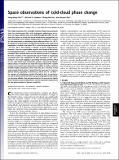Space observations of cold-cloud phase change
Author(s)
Choi, Yong-Sang; Lindzen, Richard Siegmund; Ho, Chang-Hoi; Kim, Jinwon
DownloadLindzen_Space observations.pdf (2.644Mb)
PUBLISHER_POLICY
Publisher Policy
Article is made available in accordance with the publisher's policy and may be subject to US copyright law. Please refer to the publisher's site for terms of use.
Terms of use
Metadata
Show full item recordAbstract
This study examines the vertically resolved cloud measurements from the cloud-aerosol lidar with orthogonal polarization instrument on Aqua satellite from June 2006 through May 2007 to estimate the extent to which the mixed cloud-phase composition can vary according to the ambient temperature, an important concern for the uncertainty in calculating cloud radiative effects. At -20 °C, the global average fraction of supercooled clouds in the total cloud population is found to be about 50% in the data period. Between -10 and -40 °C, the fraction is smaller at lower temperatures. However, there are appreciable regional and temporal deviations from the global mean (> ± 20%) at the isotherm. In the analysis with coincident dust aerosol data from the same instrument, it appears that the variation in the supercooled cloud fraction is negatively correlated with the frequencies of dust aerosols at the -20 °C isotherm. This result suggests a possibility that dust particles lifted to the cold cloud layer effectively glaciate supercooled clouds. Observations of radiative flux from the clouds and earth’s radiant energy system instrument aboard Terra satellite, as well as radiative transfer model simulations, show that the 20% variation in the supercooled cloud fraction is quantitatively important in cloud radiative effects, especially in shortwave, which are 10 - 20 W m[superscript -2] for regions of mixed-phase clouds affected by dust. In particular, our results demonstrate that dust, by glaciating supercooled water, can decrease albedo, thus compensating for the increase in albedo due to the dust aerosols themselves. This has important implications for the determination of climate sensitivity.
Date issued
2010-05Department
Massachusetts Institute of Technology. Department of Earth, Atmospheric, and Planetary SciencesJournal
Proceedings of the National Academy of Sciences
Publisher
National Academy of Sciences
Citation
Choi, Y.-S. et al. “Space Observations of Cold-cloud Phase Change.” Proceedings of the National Academy of Sciences 107.25 (2010): 11211–11216. ©2010 by the National Academy of Sciences
Version: Final published version
ISSN
0027-8424
1091-6490